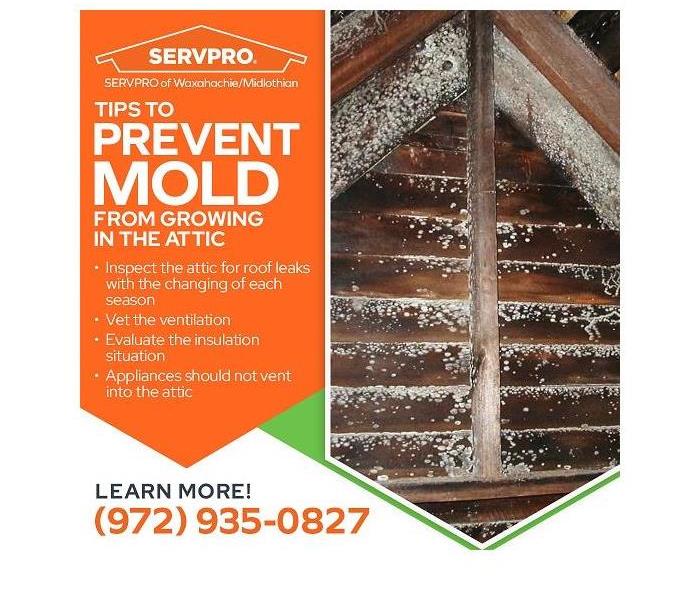Remediating a Mold Infestation in an Attic That Has Suffered Water Damage
2/11/2022 (Permalink)
Blog Summary: SERVPRO of Waxahachie/Midlothian highlights causes of mold growth in the attic and explains how the restoration team remediates the infestation.
Much-needed water damage restoration in the attic can be delayed because the attic is often neglected or ignored by the homeowner. The reasons are understandable. The attic is a part of the home that generally does not get much traffic. The annual retrieval of Christmas decorations or the placement of a box for storage is about the only time the attic receives a visit. For many Midlothian, TX, homeowners, the attic is inaccessible. The ladder may be shaky and structurally unsound, making the ascent dangerous. Once in the attic, the homeowner risks falling through the ceiling if the lighting is inadequate or the flooring is unstable or has gaps. The potential for a trip-and-fall is high.
The attic may be neglected or ignored because the environment is uninviting or harmful. Depending on the season, the attic can be very cold or stiflingly hot. Even a short visit to the attic during the summer months can stress the body, increasing the risk of a heat stroke. Dust can cause health effects.
To avoid having to venture into the attic for inspections and repairs, hire a reputable roofing contractor or attic specialist to inspect the roof and attic at least once a year. In the event of severe weather where there is evidence of roof damage, such as missing shingles or water stains on the ceiling, an inspection is especially recommended.
What Mold Needs to Thrive
Mold spores are everywhere. Problems arise when an infestation breaks out. Mold thrives in an environment where light is sparse and darkness is normal. Closets, crawl spaces, and attics are prime locations for mold growth. Mold thrives in warm temperatures but can still grow when and where temperatures are cool. Lastly, mold loves moisture, which can accumulate in the attic, creating perfect conditions for mold growth.
Common Causes of Water Intrusion in the Attic
From time to time, even well-installed roofs will develop a leak. Severe weather may damage or dislodge shingles. A falling limb may puncture the roof, the caulking around the vents may degrade over time, or the chimney may spring a leak. Sometimes squirrels and chipmunks chew their way into the attic, leaving a hole that also allows other pests, as well as water, to enter the attic.
Ventilation may not be sufficient to remove moisture and condensation from the attic. Vents clogged with debris do not allow the attic to breathe. Not all soffit vents are equal. Some soffit vents are installed for cosmetic purposes, but the vent hole is not cut out. Occasionally, the builder fails to install the proper number of soffit vents. Workers may inadvertently cover the soffit vents with insulation, severely restricting airflow in the attic. Attic air stagnates, and moisture builds up.
Appliances or exhaust fans may vent hot, moist air into the attic. The condensate pan on an HVAC system may rust or crack, allowing moisture to collect in the attic. If the drain system clogs, the condensate pan can overflow and flood the attic.
These more common causes of excessive attic moisture can be remedied, reducing mold growth in the attic. However, any mold left unchecked can grow into an infestation, leading to structural damage. These tips aim at avoiding mold infestation in the attic.
Tips to Prevent Mold From Growing in the Attic
Tip #1: Inspect the attic for roof leaks with the changing of each season.
Discoloration in the insulation and on the wood beams and flooring may indicate a water leak. Pay special attention to areas where two roofs meet at an angle. Plumbing stacks are also prone to water leaks.
Tip #2: Vet the ventilation.
Moisture levels in the attic will become elevated if ventilation is insufficient. During the winter months, warm air rises and makes its way into the attic, where the moisture condenses on cold surfaces. Adequate ventilation will allow this moisture to escape before it does any damage. Check to make sure none of the vents are covered with insulation or debris.
Tip #3: Evaluate the insulation situation.
In winter, the attic temperature should be at or near the outside temperature. Adequate insulation in the attic flooring can minimize air transfer between the living area and the attic. HVAC ductwork in the attic should also be properly insulated. Heat escaping into the attic can result in condensation.
Tip #4: Appliances should not vent into the attic.
Inspect the bathroom, dryer, and kitchen vents to ensure they vent to the home’s exterior. Reroute any vents that dump warm, moist air into the attic. This effort may require the services of a professional roofer or general contractor.
The SERVPRO technicians utilize state-of-the-art equipment, advanced moisture detection technology, and the latest cleaning techniques and strategies to mitigate a mold infestation. The EPA-approved cleaning products are safe for humans and pets. Mold removal requires technical expertise and carefully-followed safety protocols to protect both the technicians and the occupants of the structure. When the job is complete, the homeowner can be confident that the home is clean and safe.
Contact SERVPRO of Waxahachie/Midlothian to learn more about Midlothian, TX, water damage cleanup. The office can be reached by phone at (972) 935-0827 or by emailing acarey@SERVPRO10932.com



 24/7 Emergency Service
24/7 Emergency Service
